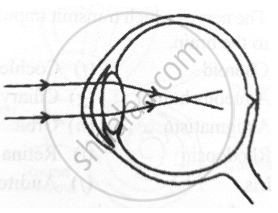Advertisements
Advertisements
प्रश्न
Answer briefly:
How do you perceive the colour of an object?
उत्तर
Photoreceptors are cells that are sensitive to light. They are of two types – rods and cones. These are present in the retina. Cones help in distinguishing colours. There are three types of cone cells – those responding to green light, those responding to blue light, and those responding to red light. These cells are stimulated by different lights, from different sources. The combinations of the signals generated help us see the different colours.
APPEARS IN
संबंधित प्रश्न
Distinguish between: blind spot and yellow spot
Give the scientific names of the following parts of the eye:
a hole in the middle of the iris.
The eyes of a person are focused (i) on a nearby object, and (ii) on a distant object, turn by turn. In which case:
the focal length of eye-lens will be the maximum?
Draw a simple diagram of the human eye and label clearly the cornea, iris, pupil, ciliary muscles, eye-lens, retina, optic nerve and blind spot.
Fill in the following blank with suitable word:
Having two eyes gives a ................field of view.
The animals of prey have:
(a) two eyes at the front
(b) two eyes at the back
(c) two eyes on the sides
(d) one eye at the front and one on the side
Name the muscles of the eye responsible for the power of accommodation.
What is the function of iris and the muscles connected to the lens in human eye?
What happens to the image distance in the normal human eye when we decrease the distance of an object, say 10 m to 1 m? Justify your answer.
Name the following:
The type of lens used for correcting myopia.
Give Technical Term:
The nutritive layer of the eye which also presents reflection of light.
Complete the following sentence with appropriate Word
The aperture in the eye through which light enters is the:
Write the name.
The screen with light sensitive cells in human eye.
Write an Explanation.
Minimum distance of distinct vision
A student sitting on the last bench can read the letters written on the blackboard but is not able to read the letters written in his text book. Which of the following statements is correct?
Given below is a diagram depicting a defect of the human eye. Answer the questions that follow:

- Give the scientific term for the defect.
- Mention one possible reason for the defect.
- What type of lens can be used to correct the defect?
The coloured portion of the eye is the ______.
The thin, transparent extension of sclerotic layer found in front of the lens is ______.
Match the following:
| Column - I | Column - II |
| 1. Retina | a. Path way of light |
| 2. Pupil | b. Far point comes closer |
| 3. Ciliary muscles | c. near point moves away |
| 4. Myopia | d. Screen of the eye |
| 5. Hypermetropia | e. Power of accommodation |
With reference to human eye answer the question that follow:
Name the part of the eye associated with the layer providing nourishment to the eye.
